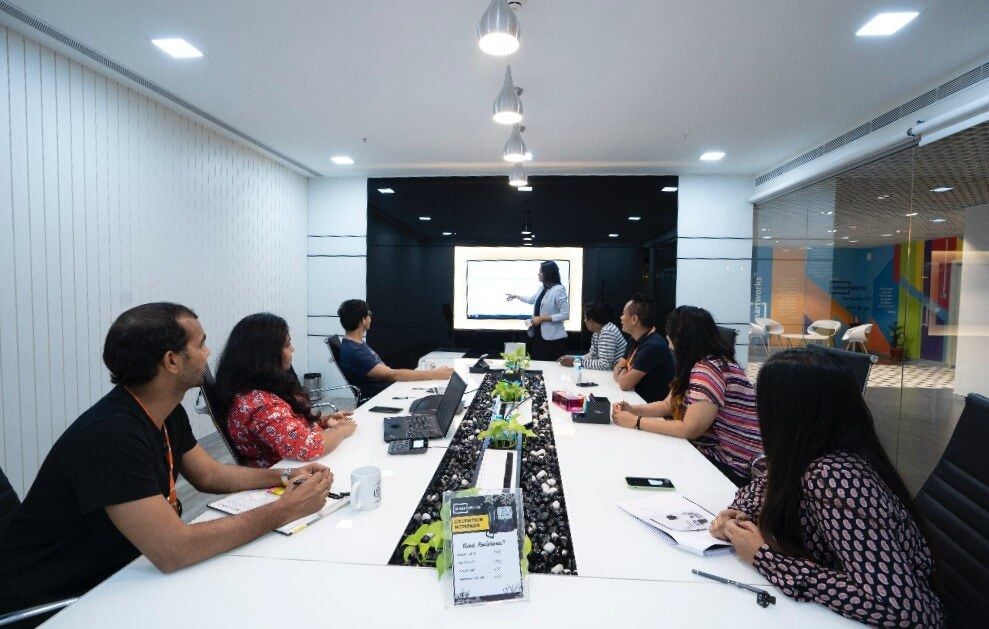Managers and employees can no longer rely on being co-located to get work done. Hybrid teams need to find new methods that equip them to work productively in or out of sync when they are not in the same place. By refocusing on work as activity, not as a place, and making the work visible to the whole team, companies can simplify planning office time, help people access their networks and optimise their use of meetings.
The volume of live meetings that teams have been required to attend has exploded since remote working went mainstream as a result of the pandemic. The traditional focus on presence-based working - people being together in one place - meant that while working remotely, teams relied on live chat or video to exchange information. So, on top of recurring meetings, people have been scheduling extra meetings and inviting more and more colleagues to attend.
When meetings get bigger and happen increasingly more often, their purpose fades and accountability for actions becomes blurred. Greater numbers of employees feeling obliged to ‘show up’ for lots of meetings makes it more difficult for them to allocate productive hours for work that needs to get done.
Stanford researchers have confirmed that continuous video calls are more tiring to deal with than other forms of digital communication - we are being exhausted by constant close-up eye contact, loss of usual mobility and the removal of our subconscious ability to interpret body language and other non-verbal cues.1 The risk that productive hours are doubly impacted by ‘Zoom’ fatigue is real. Companies must learn to adapt their workstyles to assist employees to be at their productive best, not fatigued from constant video.
This will become particularly acute in the future as businesses take into account that hybrid hours – mixed working in the office and remotely - may not occur at the same time. Remote working during the pandemic helped to accommodate individuals’ different circumstances, with some being able to re-allocate work to productive intervals outside the standard ‘9-5’.

Rethinking the optimal way to get things done
Some companies are beginning to respond to evidence of fatigue due to presence-based working, recognising the encroachment on productive capacity. Enabling staff to choose the periods when they are most productive by blocking out ‘thinking time’ is one policy being adopted. Protecting productive time is important for everyone, but the jury is out over which is optimal - letting individuals or the company decide when to do it. Late last year Google announced a 'no meetings week' giving the entire workforce advance notice to gear up to a week of productivity. Allowing individual staff to set aside block out periods unilaterally may not work unless teams act collectively.
Team leaders are used to being co-located with their employees and seeing all the information about what and how they are doing in real time. Until the pandemic, work was a place, where you had to be seen to belong. That regime has been completely disrupted. People want to return to the office but for less time than before, so businesses will need to adapt to new ways of working as the visibility of team members will vary on any given day.
Recasting work as types of activity, rather than a place makes it easier to subject traditional methods of working to process innovation. How we work should not be exempt from the broader process of change and adaptation to novelties. If companies are to remain agile, and continue to serve client relationships efficiently, they need to remain open to rethinking the optimal way to get things done. In the words of Peter Drucker, “the greatest danger in times of turbulence is not the turbulence; it is to act with yesterday’s logic.”
Why we are bad at meetings

Meetings are most effective when they are smaller, shorter, exclude passive observers and include only the relevant people to reach decisions. While there is nothing new in this, it rarely happens in internal company meetings. Internal meetings have remained the default currency for information sharing or discussing things. The majority lack purpose and take too long while inadequate preparation is done in advance to produce an agenda to brief participants. During the remote working mid-point not only was the average worker attending 13% more meetings per week, but 13.5% more attendees were attending per meeting.2
We don’t focus on people’s time as a scarce resource; but we should. We tend to view time as a commodity that we take for granted - we ask for and give time away to colleagues too readily. Much like billable hours, if time is money, then the act of ‘spending’ time or ‘paying’ attention should be proportionate to the overall allocation of internal resources to reach decisions and move work along to achieve deliverables.
Making meetings a valued asset

Moving to a hybrid environment is an opportunity to make planned meetings a valued asset. New criteria should be determined for how to use meetings more wisely, at what stage and in particular what for. Meetings should not distract people from productive work to share information or reach a consensus if this can be done asynchronously - when people can contribute to work in progress at different times.
There needs to be a structured agenda that focuses participants on desired outcomes to which they can contribute to in advance. In a hybrid world, agendas will also need to include protocol for simultaneous office and remote participation. These measures will help to reduce the volume of meetings, and liberate people’s time as the emphasis shifts to more visible groundwork and collaboration amongst teams and their networks.
Allocating participation in meetings to few or fewer relevant people also means the knowledge collected and resulting actions are properly owned and can be annotated accurately and shared to enable the wider team to easily retrieve them, at different times. Enabling teams to contribute to work asynchronously will help to shift company focus on outputs rather than on contribution by who’s most visible.
Re-imagining workspaces
It is clear that the meeting room will make a comeback to facilitate meetings where physical presence is required. Hybrid meetings bring at least part of the workforce together in person and will need to facilitate easy virtual collaboration with remote team members. Offices will need significant rethinking and redesigning, not least as employers will want to uphold rules for social distancing and manage traffic in busy areas. More rooms to foster interaction, interactivity and connection will be necessary. Offices are likely to become smaller, more focused and predominantly used for in-person human collaboration.
Near-term, companies will need to invest in equipment for hybrid meeting environments that keep people’s attention and enable them to focus, irrespective of how they are participating in the discussion. In essence, every meeting room needs to work as a ‘seamless’ space equipped with video conferencing technology that team members can easily connect to using the devices, solutions and video meeting software they are familiar with.
All meeting rooms must be ‘open’ to all users, for all types of meetings and the experience needs to be equal throughout the entire organisation. It will no longer be acceptable for people working remotely to feel left out of proceedings; providing a more immersive experience for remote participants through superior quality visual and sound offerings will be critical.
But longer-term, companies will evolve their work patterns to a potential point of divergence. Some will continue to cater for a hybrid presence in office meetings where video conferencing remains the norm, and some will adopt an ‘in-person meetings only’ office policy. Varying organisation sizes, industry sectors, cultural fit and desired behaviours will play a role in determining either approach.
Let the work decide when to be in the office
It is however clear that people will continue to desire serendipitous, ‘technology-free’ human experiences in the office. Fixed schedules of employees in the same office space on the same day is unlikely to provide the dynamic flow of people that makes coincidental networking - the chance encounter in the corridor or the canteen - more likely to happen.
New workstyles that embrace letting the work determine when to be in the office, not the day of the week, will focus companies on allocating activities that rely on physical interaction to take place in the office, in order to achieve the best results. For example, activities like troubleshooting and brainstorming thrive on the creative proximity of participants.
People have an implicit need to build social capital within their organisations and rely on coincidental networking for a mix of spontaneous camaraderie and information spillovers - picking up helpful insights from passing colleagues. Taking care to avoid stultifying the movement of people in the office will have significant cultural benefits too as companies look to prioritise wellbeing and preserve their values.
Calibrating varying levels of workforce visibility will require a convergence of upskilling, reskilling, adoption of new workstyles, location and space planning. As companies adapt to hybrid work patterns, looking at work as activity and not as a place has the potential to play a helpful role in understanding the evolution of how people work. Practical tools that simplify planning when to be in the office will help teams access their networks, reduce the number of meetings they attend and prioritise their work according to when they can be at their productive best.
- Bailenson, J.N (23 February 2021) Nonverbal overload: a theoretical argument for the causes of Zoom fatigue, Technology, Mind & Behavior
- DeFilippis, E; lmpink, S. M, Singell, M; Polzer, J. T; Sadun, R (July 2020) Collaborating during Coronavirus: The impact of Covid-19 on the nature of work, NBER Working Paper Series, No 27612.







